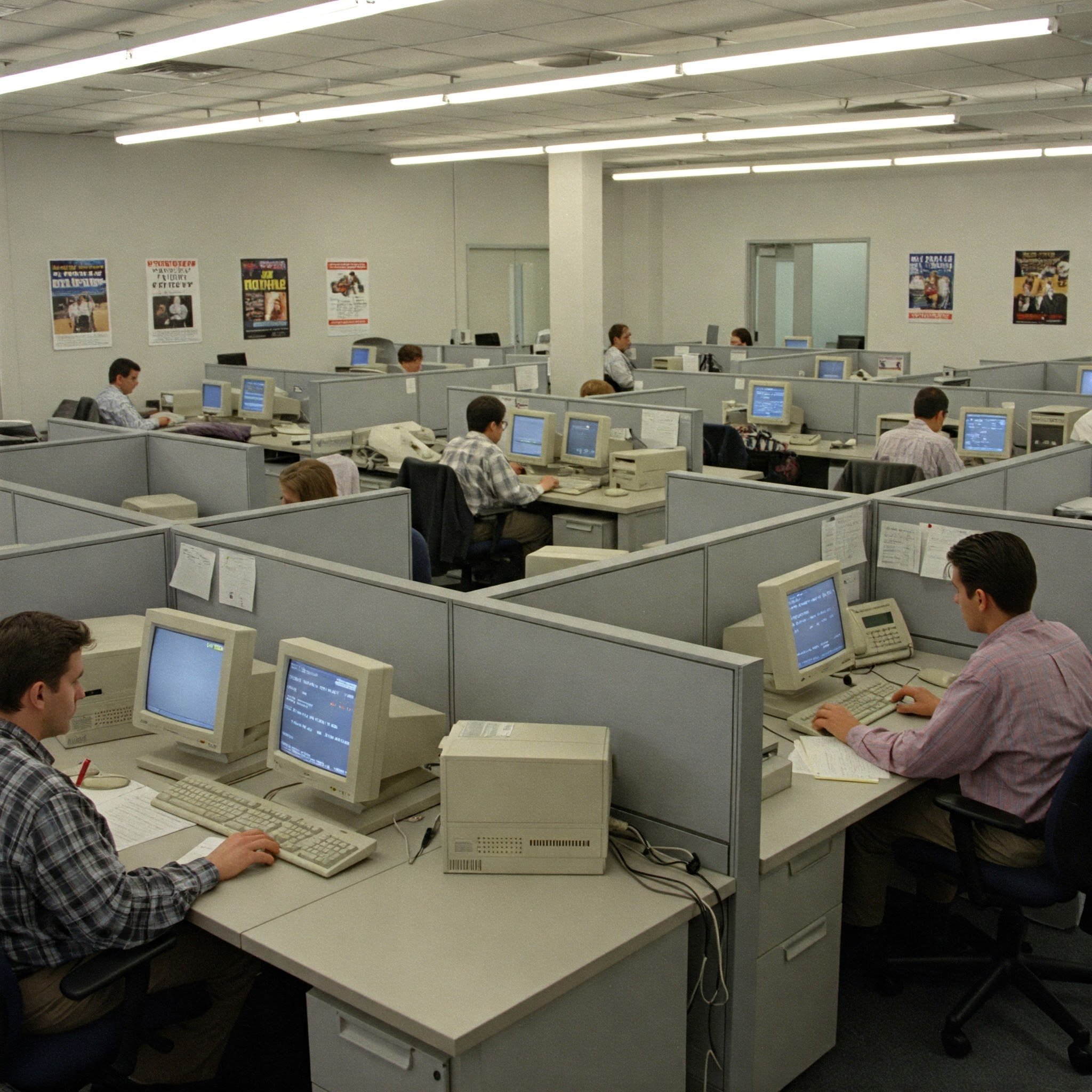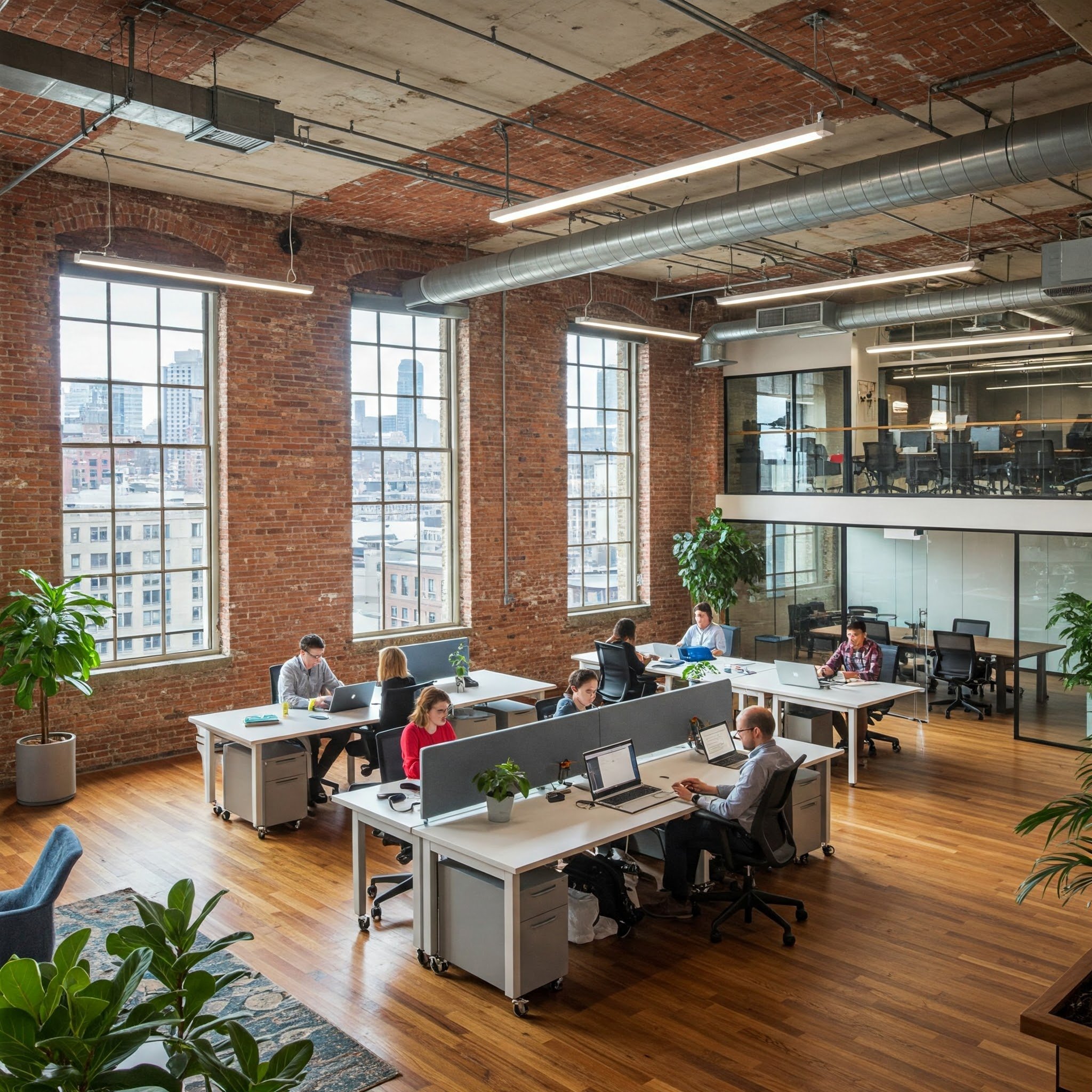The Retrofit Revolution: Unlocking Hidden Value in Older Buildings
Attract Gen Z and millennials with industrial chic and flexible, subscription-priced offices
By Robert Kroon
BEFORE. Many older buildings were designed for this type of office. This functioned in 1995. It is not what attracts younger workers now.
The modern workplace landscape is rapidly evolving, driven by the preferences of a younger, digitally native workforce and the rise of flexible work models. For building owners looking to attract Gen Z and millennial tenants, simply offering square footage is no longer enough.
AFTER. A typical Industrial Chic workplace includes exposed ceilings, polished concrete floors, natural light, indoor plants, and glass-walled conference rooms.
The key lies in reimagining older buildings through strategic retrofits that blend industrial chic aesthetics with agile functionality, creating spaces that resonate with the values and work styles of these demographics and are designed for flexible, subscription-based models. This is particularly crucial as new office construction remains stagnant, creating a prime opportunity for retrofitted spaces to capture the growing demand for flexible work arrangements.
The Power of the First Impression: Setting the Stage for Success
First impressions matter. A great view, interesting art, or a video wall can be ways to impress a visitor.
The journey to attracting Gen Z and millennial tenants begins the moment they step through the door. While the interior transformation is crucial, the initial impression sets the tone for the entire space.
A dated or uninspiring entrance can immediately deter potential tenants, regardless of the interior's appeal. Therefore, retrofitting efforts must extend to the building's entryway, creating a welcoming and engaging experience. Consider these enhancements:
A modernized facade with a fresh coat of paint, updated signage, and contemporary lighting can dramatically improve the building's curb appeal. The lobby should act as an extension of the workspace, creating a welcoming and inspiring first impression with comfortable seating, natural light, and eye-catching design elements. Incorporate digital displays, interactive kiosks, or smart building technology to showcase the building's modern amenities.
Introduce indoor plants or vertical gardens to create a sense of biophilia and enhance the space's aesthetic appeal. Ensure that the entrance is easy to navigate, with clear signage and intuitive wayfinding. By prioritizing the first impression, building owners can create a memorable and positive experience for potential tenants, increasing the likelihood of attracting and retaining these valuable demographics.
The Allure of Industrial Chic & Modern Amenities for Agile Workplaces
Smart retrofits incorporate sound-absorbing elements. The image above is shown courtesy of MergeWorks.
A coffee bar is a key amenity for attracting younger professionals who value community and connection.
Gone are the days of sterile, cookie-cutter offices. Today's younger professionals crave authenticity and transparency, qualities embodied by the industrial chic design. Exposed brick walls, polished concrete floors, and visible HVAC systems transform historical structures into visually compelling workspaces. This raw aesthetic, often found in repurposed industrial buildings, speaks to a generation that values character and history. To enhance this modern environment, and make it suitable for subscription based workplaces, consider adding:
A Vibrant Coffee Bar: A central coffee bar acts as a social hub, fostering informal interactions and collaboration. It's a key amenity for attracting younger professionals who value community and connection.
Glass-Walled Conference Rooms: These create a sense of openness and transparency, promoting collaboration while still providing dedicated meeting spaces. The glass walls also allow for ample natural light, enhancing the overall workspace environment.
Private Conversation Pods: These provide quiet, secluded spaces for focused work, private conversations, or quick calls. These pods offer a balance between collaborative and individual work environments.
Configurable Layouts: Design the spaces to be easily reconfigured, so that a portion of the building can be sectioned off, or expanded, as needed for subscription based tenants.
However, the "unfinished" look presents acoustical challenges. To combat this, smart retrofits incorporate sound-absorbing panels, strategically placed rugs, and acoustic ceiling treatments, ensuring both aesthetic appeal and functional comfort.
Agile Furniture: The Key to Flexibility and Subscription-Friendly Spaces
In an agile workplace, there is no uniform way users require power. Some devices utilize USB-C, while others still depend on AC connections. August Berres desks accommodate both, eliminating the need for wall connections and unsightly power strips and extension cords.
The modern workplace, especially one designed for subscription models, is dynamic, demanding flexibility and adaptability. Agile furniture, with its modular designs and integrated technology, perfectly complements the industrial chic aesthetic.
These pieces allow for easy reconfiguration of workspaces, fostering collaboration and supporting diverse work styles. Crucially, agile furniture addresses cord management, eliminating the visual clutter that detracts from the clean lines of industrial chic design.
Integrated power outlets and USB ports ensure seamless tech integration, catering to the digital needs of Gen Z and millennials, and those who may only be using the space for a short period of time.
Beyond Aesthetics: Meeting the Needs of a New Generation and Flexible Leases
For workplaces that are often reconfigured, mobile screens can separate workstations or direct foot traffic. August Berres Wallies (shown above) can be configured with fabric, wood, erasable marker boards, plexiglass, or accessory grids for added utility.
Attracting younger tenants and those looking for flexible workspace options requires more than just a stylish design. Retrofits should prioritize:
Technology Integration: High-speed internet, robust Wi-Fi, and smart building systems are non-negotiable.
Sustainability: Gen Z and millennials are environmentally conscious. Retrofits should incorporate sustainable materials, energy-efficient systems, and waste reduction strategies.
Community and Collaboration: Open layouts, communal spaces, and flexible meeting rooms foster a sense of community and encourage collaboration.
Well-being: Natural light, ergonomic furniture, and access to outdoor spaces contribute to employee well-being and productivity.
Authenticity: The desire for authentic work environments is high with younger generations. The use of original building materials, and the showcasing of the buildings history is a plus.
Flexibility and Scalability: The building must be able to scale, and be flexible enough, to handle tenants that are looking for short term work space rentals.
Data-Driven Design
Older buildings with wood floors make attractive Industrial Chic facilities.
While anecdotal evidence supports the appeal of industrial chic and agile furniture, data from industry research and academic studies reinforces these trends.
Reports from organizations like JLL and Gensler highlight the importance of flexibility, technology, and sustainability in attracting younger tenants. Studies on workplace design emphasize the impact of environment on employee satisfaction and productivity, further validating the need for thoughtful retrofits.
The Future of Retrofitting: Agile Spaces for a Flexible Future
Agile workplaces need agile display solutions. This is an August Berres Juce with a 65” monitor; mobile and cordless.
By embracing industrial chic design, integrating agile furniture, and prioritizing the needs of Gen Z and millennials, building owners can transform older structures into vibrant, sought-after workspaces.
By configuring these spaces for subscription-based pricing and flexible leases, building owners can tap into a growing market of businesses and individuals seeking adaptable workspace solutions. This approach not only attracts tenants but also revitalizes urban areas, creating a win-win scenario for landlords and the next generation of professionals.
Furthermore, the current lack of new office construction presents a unique opportunity for retrofitted spaces to capture market share. As companies increasingly adopt flexible work arrangements and seek to reduce long-term lease commitments, subscription-based models in retrofitted buildings offer appealing alternatives to traditional office leases.










